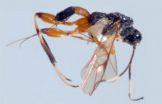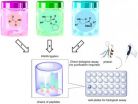(Press-News.org) Alzheimer's disease experts at NYU Langone Medical Center and elsewhere are reporting success in specifically harnessing a mouse's immune system to attack and remove the buildup of toxic proteins in the brain that are markers of the deadly neurodegenerative disease.
Reporting on their experiments in the journal Acta Neuropathologica Communications online Sept. 3, the researchers say the work advances the development of more effective clinical treatments for Alzheimer's because their immune booster reduced both amyloid beta plaques and tau tangles. Previous immunomodulatory efforts, they say, were singularly successful in decreasing amyloid beta deposits but made limited progress in reducing the buildup of tau proteins that are also a key disease characteristic linked to progressive brain damage.
"Our study results confirm that precisely boosting the immune system in mice can work effectively against Alzheimer's disease, a treatment model that could very well be applied in humans," says senior study investigator and neurologist Thomas Wisniewski, MD, a professor at NYU Langone.
If further animal testing proves successful, human clinical trials could begin within a year, says Wisniewski, who also serves as director of NYU Langone's Center for Cognitive Neurology and co-director of its Alzheimer's Disease Center.
In their written report, the research team calls their findings the first positive results for targeted stimulation of the natural, or innate immune system to both prevent the onset of Alzheimer's disease in animals bred to develop dementia, and to reverse its symptoms after the disease has already set in.
Using the dementia-prone mice, the team gave monthly injections of an immune system booster known as a type B, CpG, oligodeoxynucleotide that specifically binds to Toll-like receptor 9, or TLR9 for short. Activation of TLR9 triggers an immune response. Tests in mice that received the immune system booster injections showed that amyloid plaque formation was 50 percent to 70 percent less than in mice that received no therapy. Reductions in amyloid beta were almost the same for mice treated early on, at age 7 months, and before disease onset, compared to mice treated at age 11 months, which already had mild dementia. Immunostaining tests on brain tissue in treated mice showed one to two times fewer damaged neurons containing disease-related tau aggregates than in untreated mice.
Further cognitive, behavioral testing showed that treated mice made roughly half the number of mistakes in finding their way in water-reward mazes than untreated mice. Dementia-associated brain inflammation was also halved in treated mice, the researchers report, with "classic signs of a traditional immune response against both amyloid beta and tau proteins," as demonstrated by the presence of immune system cytokines and T-helper cells.
According to researchers, treated mice behaved "almost like normal" mice that never develop Alzheimer's-like symptoms.
Wisniewski says that unlike vaccines, which try to trigger an antibody-mediated stimulation of the body's immune system, his team's new approach attempts to "jump start and rejuvenate" the brain's natural microglial cell repair function. The breakdown of microglial repair — possibly from aging — has been linked for decades to the formation and removal of amyloid plaques and tau tangles in Alzheimer's disease.
Researchers say they selected TLR9 as the immune booster because it was a known stimulant for removing germs. A bacterial cytosine-guanosine sequence, or CpG, such as type B, CpG, oligodeoxynucleotide, was chosen to help activate TLR9 on brain cells because previous testing had shown it to be effective at triggering an immune response in both mice and humans, with very few side effects.
According to study lead investigator Henrieta Scholtzova, MD, PhD, a clinical fellow at NYU Langone, the latest series of experiments build on the team's original observations in 2009, also in mice, that CpG immune boosting was possible, and could reduce amyloid plaque formation.
"Now that we have shown that we can influence microglial function in Alzheimer's disease, to both prevent and repair tau-damaged brain tissue, then it is highly plausible that our treatment approach could also be applied to other neurodegenerative diseases tied to aging," says Scholtzova.
Alzheimer's disease remains the leading cause of dementia worldwide. The disease, which has no effective treatment, afflicts some 5.2 million Americans, mostly women, killing up to a half-million each year.
INFORMATION:
Funding support for the study was provided by the U.S. National Institutes of Health. Corresponding federal grant numbers are RO1 AG20245, RO1 NS073502, ULI TR000038, and R01 CA016087. Additional research support was received from the Seix Dow Foundation and the Alzheimer's Association, and grant IIRG-12-239474.
Besides Wisniewski and Scholtzova, other researchers involved in these experiments were Peter Chianchiano, BA; Jason Pan, BA; Yanjie Sun; and Fernando Goni, PhD. Additional research support was provided by Pankaj Mehta, MD, PhD, at the New York State Institute for Basic Research in Developmental Disabilities on Staten Island, NY.
For more information, go to:
http://adc.med.nyu.edu/researchers/affiliated-labs/dr-thomas-wisniewski http://www.actaneurocomms.org/content/2/1/101
About NYU Langone Medical Center:
NYU Langone Medical Center, a world-class, patient-centered, integrated academic medical center, is one of the nation's premier centers for excellence in clinical care, biomedical research, and medical education. Located in the heart of Manhattan, NYU Langone is composed of four hospitals — Tisch Hospital, its flagship acute care facility; Rusk Rehabilitation; the Hospital for Joint Diseases, the Medical Center's dedicated inpatient orthopaedic hospital; and Hassenfeld Children's Hospital, a comprehensive pediatric hospital supporting a full array of children's health services across the Medical Center — plus the NYU School of Medicine, which since 1841 has trained thousands of physicians and scientists who have helped to shape the course of medical history. The Medical Center's tri-fold mission to serve, teach, and discover is achieved 365 days a year through the seamless integration of a culture devoted to excellence in patient care, education, and research. For more information, go to http://www.NYULMC.org, and interact with us on Facebook, Twitter, and YouTube.
Media Contact:
David March
212 .404.3528│david.march@nyumc.org
Targeted immune booster removes toxic proteins in mouse model of Alzheimer's disease
Clinical trials could begin in 2015
2014-09-08
ELSE PRESS RELEASES FROM THIS DATE:
Nearly half of older adults have care needs
2014-09-08
Nearly half of older adults – 18 million people—have difficulty or get help with daily activities, according to a new study.
Researchers from the University of Michigan and the Urban Institute analyzed data from a national sample of older adults drawn from Medicare enrollment files. In all, 8,245 people were included in the 2011 the National Health and Aging Trends Study. The analysis was published in the current (September 2014) issue of the Milbank Memorial Quarterly.
"Although 51 percent reported having no difficulty in the previous month, 29 percent reported receiving ...
The future of our crops is at risk in conflict zones, say Birmingham scientists
2014-09-08
Wild species related to our crops which are crucial as potential future food resources have been identified by University of Birmingham scientists, however, a significant proportion are found in conflict zones in the Middle East, where their conservation is increasingly comprised.
The scientists have identified 'hotspots' around the globe where crop wild relatives (CWR) – species closely related to our crops which are needed for future crop variety development – could be conserved in the wild in order to secure future global food resources.
The hotspot where CWR ...
New parasitoid wasp species found in China
2014-09-08
For the first time, wasps in the genus Spasskia (family: Braconidae) have been found in China, according to an article in the open-access Journal of Insect Science. In addition, a species in that genus which is totally new to science was also discovered.
The new species, Spasskia brevicarinata, is very small — male and female adults are less than one centimeter long. It is similar to a previously described species called Spasskia indica, but the ridges on some of its body segments are different. In fact, the species epithet brevicarinata reflects a short ridge on its ...
Unusual immune cell needed to prevent oral thrush, Pitt researchers find
2014-09-08
PITTSBURGH, Sept. 8 – An unusual kind of immune cell in the tongue appears to play a pivotal role in the prevention of thrush, according to the researchers at the University of Pittsburgh School of Medicine who discovered them. The findings, published online today in the Journal of Experimental Medicine, might shed light on why people infected with HIV or who have other immune system impairments are more susceptible to the oral yeast infection.
Oral thrush is caused by an overgrowth of a normally present fungus called Candida albicans, which leads to painful white lesions ...
'Pick 'n' Mix' chemistry to grow cultures of bioactive molecules
2014-09-08
Chemists at ETH-Zürich and ITbM, Nagoya University have developed a new method to build large libraries of bioactive molecules – which can be used directly for biological assays – by simply mixing a small number of building blocks in water.
Zürich, Switzerland and Nagoya, Japan – Professor Jeffrey Bode of ETH-Zürich and the Institute of Transformative Bio-Molecules (ITbM) of Nagoya University, and his co-worker have established a new strategy called "synthetic fermentation" to rapidly synthesize a large number of bioactive molecules, which can be directly screened in ...
Trial shows improved overall survival for patients with liver cancer not amenable to surgery
2014-09-08
Singapore, 04 September 2014 – The mature results from a trial conducted by the Asia-Pacific Hepatocellular Carcinoma Trials Group led by the National Cancer Centre Singapore (NCCS) and Singapore General Hospital (SGH) have shown that patients who suffer from inoperable advanced hepatocellular carcinoma (HCC) may have a chance to live significantly longer by using a combined therapy.
The multi-centre phase II clinical trial was conducted at four Asia Pacific tertiary medical centres to evaluate the efficacy of combining two existing treatment modalities, Sorafenib and ...
New knowledge of cannabis paves the way for drug development
2014-09-08
Revolutionary nanotechnology method could help improve the development of new medicine and reduce costs. Researchers from the Nano-Science Center and the Department of Chemistry at the University of Copenhagen have developed a new screening method that makes it possible to study cell membrane proteins that bind drugs, such as cannabis and adrenaline, while reducing the consumption of precious samples by a billion times.
About 40% of all medicines used today work through the so-called "G protein-coupled receptors". These receptors react to changes in the cell environment, ...
Study examines discrimination among homeless adults in Toronto with mental illness
2014-09-08
TORONTO, Sept. 8, 2014—Vulnerable populations in ethnically diverse Toronto reported more discrimination by health care workers based on their housing status, mental health or substance abuse issues than race, a new study has found.
Forty-two per cent of people surveyed reported at least one form of perceived discrimination by health care workers, lead author Dr. Vicky Stergiopoulos wrote in a paper published today in the journal BMC Health Services Research.
The most prevalent form of perceived discrimination was due to mental illness or substance abuse (33 per cent) ...
Poor recording of physical health and medication could be causing dementia trials to fail
2014-09-08
Dementia trials could be failing because they all-too-often overlook the physical health of patients – according to new research from the University of East Anglia and Aston University.
More than 60 per cent of people with dementia are estimated to have three or more other conditions (co-morbidities).
The research shows how the combined effects of co-morbidities including diabetes, lung disease, arthritis and chronic heart failure are not being adequately described in dementia trials.
It investigates the extent of co-morbidities in people with dementia and the recording ...
Food craving is stronger, but controllable, for kids
2014-09-08
Children show stronger food craving than adolescents and adults, but they are also able to use a cognitive strategy that reduces craving, according to new research published in Psychological Science, a journal of the Association for Psychological Science.
"These findings are important because they suggest that we may have another tool in our toolbox to combat childhood obesity," says psychological scientist and lead researcher Jennifer A. Silvers, a post-doctoral fellow at Columbia University in the laboratory of Professor Kevin Ochsner.
Most interventions aimed at ...
LAST 30 PRESS RELEASES:
UT Health San Antonio awarded $3 million in CPRIT grants to bolster cancer research and prevention efforts in South Texas
Third symposium spotlights global challenge of new contaminants in China’s fight against pollution
From straw to soil harmony: International team reveals how biochar supercharges carbon-smart farming
Myeloma: How AI is redrawing the map of cancer care
Manhattan E. Charurat, Ph.D., MHS invested as the Homer and Martha Gudelsky Distinguished Professor in Medicine at the University of Maryland School of Medicine
Insilico Medicine’s Pharma.AI Q4 Winter Launch Recap: Revolutionizing drug discovery with cutting-edge AI innovations, accelerating the path to pharmaceutical superintelligence
Nanoplastics have diet-dependent impacts on digestive system health
Brain neuron death occurs throughout life and increases with age, a natural human protein drug may halt neuron death in Alzheimer’s disease
SPIE and CLP announce the recipients of the 2025 Advanced Photonics Young Innovator Award
Lessons from the Caldor Fire’s Christmas Valley ‘Miracle’
Ant societies rose by trading individual protection for collective power
Research reveals how ancient viral DNA shapes early embryonic development
A molecular gatekeeper that controls protein synthesis
New ‘cloaking device’ concept to shield sensitive tech from magnetic fields
Researchers show impact of mountain building and climate change on alpine biodiversity
Study models the transition from Neanderthals to modern humans in Europe
University of Phoenix College of Doctoral Studies releases white paper on AI-driven skilling to reduce burnout and restore worker autonomy
AIs fail at the game of visual “telephone”
The levers for a sustainable food system
Potential changes in US homelessness by ending federal support for housing first programs
Vulnerability of large language models to prompt injection when providing medical advice
Researchers develop new system for high-energy-density, long-life, multi-electron transfer bromine-based flow batteries
Ending federal support for housing first programs could increase U.S. homelessness by 5% in one year, new JAMA study finds
New research uncovers molecular ‘safety switch’ shielding cancers from immune attack
Bacteria resisting viral infection can still sink carbon to ocean floor
Younger biological age may increase depression risk in older women during COVID-19
Bharat Innovates 2026 National Basecamp Showcases India’s Most Promising Deep-Tech Ventures
Here’s what determines whether your income level rises or falls
SCIE indexation achievement: Celebrate with Space: Science & Technology
Children’s Hospital Colorado performs region’s first pediatric heart and liver dual organ transplant
[Press-News.org] Targeted immune booster removes toxic proteins in mouse model of Alzheimer's diseaseClinical trials could begin in 2015



